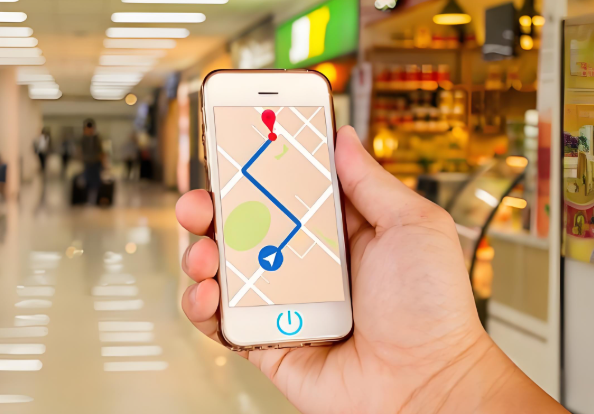With the deep integration of the Internet of Things and artificial intelligence, indoor positioning technology has become core infrastructure for smart cities, Industry 4.0, healthcare, and senior care. Whether it's intelligent navigation in shopping malls, tracking personnel and supplies in factories, or real-time monitoring of the elderly in nursing homes, indoor positioning technology is reshaping the boundaries of spatial management with centimeter-level accuracy.

Wi-Fi Positioning
Technical Principle
Wi-Fi positioning measures the RSSI (Receiving Signal Strength Index) of wireless access points (APs) received by mobile devices and combines it with a pre-collected "signal strength-location" fingerprint database to achieve positioning. Its core approach is to utilize the path loss model of signal propagation to convert received signal strength into distance information, which is then calculated using triangulation or multilateration algorithms. Some systems use the "nearest neighbor method," directly using the location of the AP with the strongest signal as the estimated value.
Performance and Characteristics
Advantages: Leveraging existing Wi-Fi infrastructure, it requires no additional hardware deployment, resulting in low costs. It also offers wide coverage (approximately 90 meters for a single AP), making it suitable for large spaces. Limitations: Signals are susceptible to environmental interference (such as human obstruction and multipath), resulting in large fluctuations in positioning accuracy (1-20 meters). The fingerprint database requires regular updates to adapt to changes in AP locations, resulting in high maintenance costs.
3. Typical Applications
Shopping Mall Navigation: Combined with floor maps, it provides users with store search and route planning.
Hospital Management: Tracks the location of medical equipment and optimizes resource allocation.
Bluetooth Positioning
Technical Principle
Bluetooth positioning is primarily based on Bluetooth Low Energy (BLE) beacon technology. The system deploys multiple Bluetooth beacons indoors, which continuously broadcast a unique ID and signal strength. After receiving the beacon signal, the mobile device calculates its location by measuring the RSSI value and combining it with a trilateration algorithm. Some systems use a "fingerprint positioning method" to pre-collect the correlation between beacon signal strength and location.
Performance Characteristics
Advantages: Beacons are compact, low power (with a battery life of several years), and flexible to deploy. Positioning accuracy can reach 1-5 meters, making them suitable for small-scale scenarios. Limitations: Signal penetration is weak and easily interfered with by metal obstacles; beacon density directly affects accuracy, increasing deployment costs when high precision is required.
Typical Applications
Museum Guides: Automatically play audio guides when visitors approach exhibits.
Warehouse Logistics: Track the location of items on shelves to improve picking efficiency.
Ultra-Wideband (UWB) Positioning
Technical Principle
UWB technology transmits nanosecond-long pulse signals and uses time difference of arrival (TDOA) or angle of arrival (AOA) algorithms to achieve positioning. Its core advantage lies in its extremely wide bandwidth (3.1-10.6 GHz), which allows it to penetrate non-metallic obstacles such as concrete and is highly resistant to multipath interference. The system consists of anchor nodes (known locations), tags (devices to be located), and a positioning engine. Distance is calculated by measuring the pulse time of flight.
Performance Characteristics
Advantages: Positioning accuracy reaches up to 0.1-0.3 meters, latency is less than 100 milliseconds, and it supports tracking highly dynamic targets (such as robots and automated guided vehicles). Limitations: Hardware costs are high (anchor nodes cost hundreds of yuan each), requiring pre-deployment of an anchor node network; signals are susceptible to interference from metal reflections, requiring optimized anchor node layout.
Typical Applications
Industrial Manufacturing: Real-time tracking of production line workers and equipment to optimize process coordination.
Smart Elderly Care: UWB wristbands for disabled elderly people to prevent wandering and detect falls.
RFID Positioning
Technical Principle
RFID positioning achieves location by reading tag signals through fixed readers. The system is divided into two modes: active RFID (tags actively transmit signals) and passive RFID (tags passively reflect signals). Active RFID uses the distance between the tag and reader (RSSI or TDOA) combined with a centroid algorithm for positioning; passive RFID relies on reader coverage to divide the area.
Performance Characteristics
Advantages: Low tag cost (passive tags cost only a few cents), suitable for large-scale deployment; fast recognition speed (in milliseconds), suitable for high-frequency positioning scenarios.
Limitations: Short range (passive tags, approximately 10 meters), requiring dense reader deployment; weak anti-interference capability, susceptible to metallic environments.
Typical Applications
Book Management: Tracking book locations in libraries to reduce mis-shelving.
Asset Inventory: Locating tools and equipment in factories to improve inventory efficiency.
Visual Positioning
Technical Principle
Visual positioning achieves positioning by matching environmental features (such as landmarks and textures) captured by cameras with a pre-collected visual map. Its core lies in extracting feature points using deep learning algorithms (such as convolutional neural networks) and combining them with SLAM (Simultaneous Localization and Mapping) technology to construct a 3D spatial model. The system operates in two modes: active positioning (using a user's device to capture images) on a mobile device and passive positioning (using cameras deployed within the venue).
Performance Characteristics
Advantages: Requires no additional hardware deployment, leveraging existing camera resources; high positioning accuracy (reaching centimeter-level), suitable for complex environments.
Limitations: Active positioning requires the user to keep the camera on, resulting in high power consumption; passive positioning requires a large number of high-definition cameras, resulting in high engineering costs.
Typical Applications
Unmanned Retail: Tracking customer behavior in supermarkets to optimize shelf layout.
Security Monitoring: Locating suspicious individuals at airports to improve security response speed.
Multi-Technology Integration
A single technology cannot meet all scenario requirements, and multi-technology integration has become an industry trend. For example:
UWB + Bluetooth: UWB provides high-precision positioning, while Bluetooth beacons achieve low-cost regional coverage.
Wi-Fi + Vision: Wi-Fi solves large-scale positioning, while vision positioning optimizes local accuracy.
5G + MEMS Inertial Navigation: 5G provides low-latency communication, while inertial sensors compensate for signal blind spot errors.
With the optimization of AI algorithms and the reduction of hardware costs, indoor positioning technology is evolving from "function implementation" to "scenario empowerment." In the future, indoor positioning will be deeply integrated with technologies such as AR navigation and digital twins to provide more accurate and intelligent solutions for smart space management.